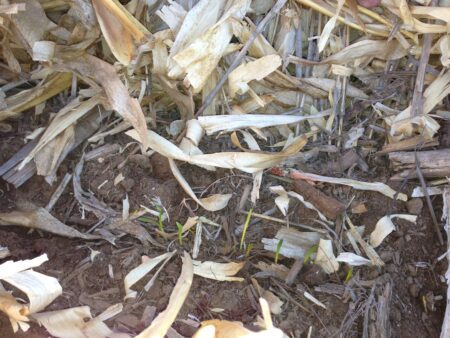
While many people in the southeast US are experiencing devastating loss from the hurricane and too much water, farmers in the Midwest are praying for an end to the drought. So why in the middle of a drought would farmers choose to plant yet another crop, one that will use whatever moisture is available and may not even come up?
Scott Ravenkamp, Contract Production Manager here at Green Cover, is a big believer in rye, even in drought conditions. “The only way to guarantee a rye failure is to not plant it,” says Scott. And from personal experience he knows that first hand.
In the fall of 2012, a year that many remember as one of the hottest and driest years on record, Scott planted a field of rye in hopes of harvesting it for seed. He was skeptical that it would even come up, especially in the parched Eastern Colorado soil.
The winter didn’t prove to be much help, with only trace amounts of precipitation falling on the ground. In February, some visitors, Brian Berns, co-founder of Green Cover, along with his wife Christi made a trip out to see Scott. Brian was curious about the rye and wanted to take a look. With little hope or enthusiasm, Scott reluctantly took Brian and Christi out to see the field of rye.
What Scott was greeted with was nothing short of a miracle, a miracle that rye can consistently perform in the toughest conditions. The rye had germinated and grown up enough to even identify rows. They went on to harvest that rye crop for seed that summer.

Now that Scott manages the contract seed production for Green Cover he says he’s not surprised anymore that the rye could do that. He’s seen countless other rye crops perform in less than ideal conditions and still provide erosion control, continue feeding the soil microbial system, provide feed for livestock, and even be harvested as a seed crop.
Setting realistic expectations is the key to success with this. “You can’t expect to plant rye this fall and have it come up in two weeks. You have to be patient and willing to wait. Anything is better than nothing, probably exponentially better, and a plant that is photosynthesizing in your field is doing a whole lot more good for the system than sitting in a barn or warehouse.”
Scott reminds people to increase the seeding rate slightly when planting in a drought and be ready to do an early termination if the drought continues in the spring. But that is the worst case scenario. If the faucet turns on and winter snow is followed by adequate spring rain, the rye will help prevent erosion and could provide extra livestock feed. Either way, rye is one of those crops that can just get the job done as long as we are willing to step out of the way and let nature do its thing.
If you’re thinking about planting a cover crop this fall whether you are in a drought or not, give our sales team a call and we are happy to have a conversation about your unique situation, talk through recommended planting times when in a drought and find the right solution for you.
